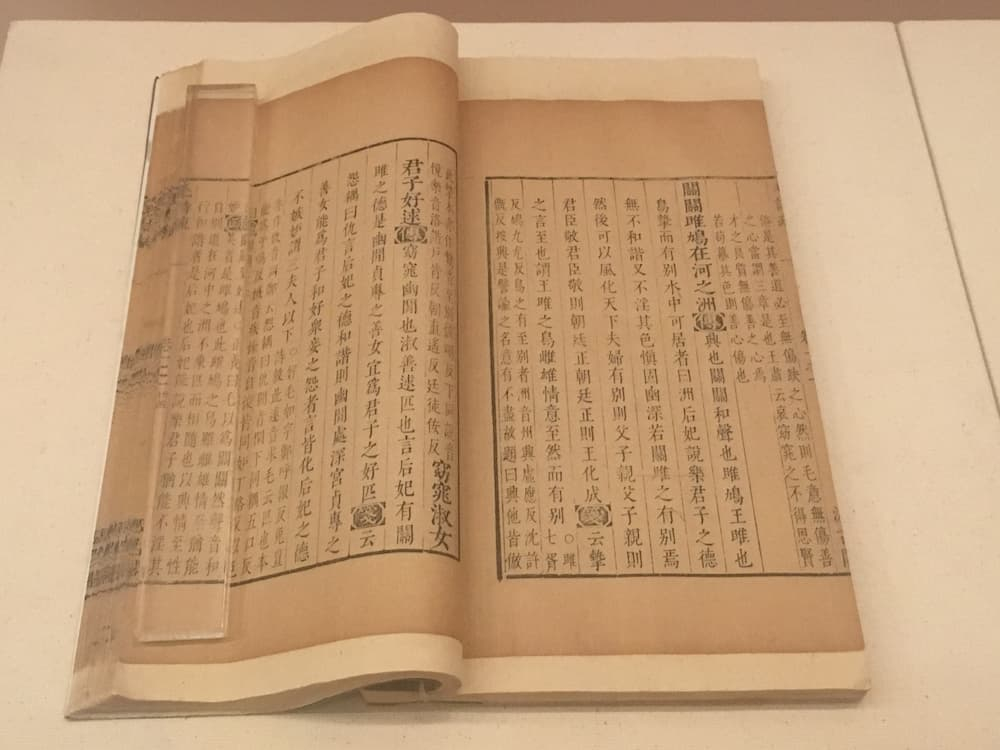
Classic of Songs
Splendid
Chi Culture
Topic
Classic of Songs
The first poetry collection in China, the Shi jing, or Classic of Songs, was compiled in the pre-Qin period (times before 221 BCE), and consists of 305 poems written in the 500-odd years between the early Western Zhou dynasty and the mid-Spring and Autumn period (ca. 1100–ca. 600 BCE). It marks the glorious start of Chinese poetry, and has been a standard bearer of Chinese culture and the earliest sign of its cultural development. It had a great influence on the formation and development of Chinese literature and civilization.
The Classic of Songs originates from the decision in the Zhou dynasty (ca. 1100–256 BCE) to collect folk songs. Court musicians edited popular songs, set them to music, and performed them for the ruler. This was done to help him understand the state and sentiment of the masses. Entries in the Classic of Songs are categorized into guo feng (airs of the states, 160 pieces in all), ya, both greater and lesser, (court hymns, 105 pieces), and song (eulogies, 40 pieces). Feng refers to the local music of the vassal states, ya to the songs near the capital of the Zhou dynasty, and song to ritual dances associated with the veneration of the ancestors. Because the Classic of Songs is a collective work of remote antiquity, most of its pieces are of unknown authorship. In ancient times there were different versions of the text; most of these have been lost. The current version was annotated by Mao Heng, a scholar of the Han dynasty (206 BCE–220 CE).
The Classic of Songs is an anthology of works by different authors, on different themes, and of different genres. Spanning more than 500 years, it is comprised of poems on historical events, sacrificial offerings, banquets, government, farming, labor service, wives pining for their traveling husbands, love, married life, and familial affection. The five historical poems beginning with “Sheng min” (The birth of the Zhou clan) sketch the origins of the Zhou clan, and the hardship of founding the state. They constitute the first chapter of Chinese history. The San song (three eulogies) which were sung at sacrificial ceremonies are solemn and stately, bespeaking the aspiration for prosperity of the clan, the nation, and the individual’s life. Banquet poems, sung on the occasion of feasts and banquets, not only depict sumptuous food and wine, but also convey the hierarchical relationship that obtained between host and guests. They were actually intended for strengthening patriarchal kinship and consolidating the states. Political poems reflect the social unrest in the late Western Zhou dynasty (ca. 1100–771 BCE) and include political criticism and advice. The Zhou dynasty was an agricultural society and the farming poems describe people engaging in agricultural activities, and capture the simple, hardworking people’s love of nature as well as conveying local flavor. In ancient times when people left their home areas, they composed songs expressing their homesickness. Poems on the theme of labor service are a reflection of the suffering of people conscripted for battle. Poems of women pining for their husbands tell of the longing of women for their loved ones who are travelling away from home. There are many poetic masterpieces about married life describing lovesickness, the joys of newlyweds, or tragic humiliation and abandonment of women by their husbands. Poems of familial affection reflect filial piety, marital harmony, and brotherly love, epitomizing the benevolent and genial kinship of Chinese people.
The Classic of Songs has distinctive literary features. Its content is primarily four-syllable line poems. It is the origin of this genre and contains the most exemplary four-character verses in ancient China. Its composition includes heavy use of parallelism, both in expressions and structure, which creates a flowing rhythm and a recurring aesthetic effect. A rich variety of diction is used for precise expression. Reduplication and alliteration are both frequently used to create a beautiful musical effect. The rhythm is natural and harmonious, exerting much influence on future generations. Traditional Chinese scholars summed up the literary techniques employed in the Classic of Songs as fu (direct narration), bi (explicit comparison), and xing (implied comparison), which are also techniques used in Chinese traditional poetry.
The Classic of Songs is an ancient anthology of poems produced in China over 2,000 years ago. Its great spirit of realism, innovative exploration of literary subjects, themes rich in ethnic characteristics, its use of fu, bi, and xing in artistic expression, and its rustic charm had a profound influence on the various types of Chinese art for centuries. It is also an encyclopedia of ancient Chinese culture and a rich source for studying Chinese culture, national psychology, and cultural traditions.



